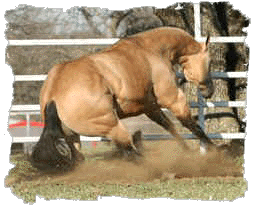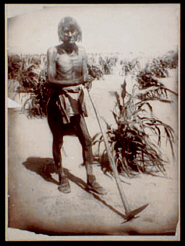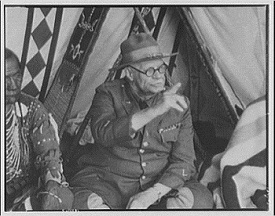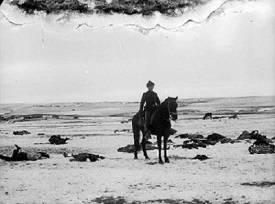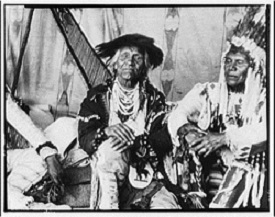Black Kettle & White Antelope, the conspiracy.
Black Kettle; Cheyenne, birth name Moketarato; lived 1803-1868, he became a Cheyenne Chief at the age of 21.
The most popular part of the history of America from the 1860's is the Civil War. From the beginning of the Civil War to this day, much of the attention of the general population of historians has been focused on it as one of the the main historical events of the time. Perhaps that is why so little attention has been given to other conflicts of the time that were in their own way just as significant. However the reasons not so noble, the causes not so justified, and in there end, there was, and is no glory. In there wake only broken Nations of people and whole races of people lost forever.
What was at the time called the Indian wars, and is still referenced as that to this day were in truth the invasion, the attack and massacre of the civilized indigenous people who lived on the land and had lived there for the most part in peace for thousands of years. Yes they had conflicts and there were good guys and bad guys just like in any other race or culture. In the beginning of the European invasion the majority of these native people chose to make peace and welcome the newcomers rather than fight but they were robbed and killed anyway. The ones who choose to fight were just as justified in their cause as you would be if a foreign army invaded your country and their soldiers came marching down your street killing your neighbors and were approaching your property where your family has lived for many generations. This is what the indigenes people of the American continent were faced with for more than five hundred years.
More than 50 years of Black Kettle's life was spent striving for peace and the preservation of his people. Balance, compromise or living together with peace and acceptance would never be allowed by the newcomers. The Cheyenne had survived peacefully for these years by gradually trading their land away for peace. By the 1860's hundreds of thousands of settlers had made their way into the Cheyenne territory. At this point in time only remote peaceful tribes and allusive groups of warriors of combined tribes remained off of reservations and their time was growing short. Even though the U.S. Government was involved in the Civil War they were still able to support and man the forts of the west and send out companies of soldiers to seek out and kill Indians. At the time killing free Indians would have been funded by the Federal Government as a military operation, using tax dollars. In fact many places had bounties on free Indians, so much for adult male Indian scalps and they would pay a price for Indian women to be used as servants and sex objects at best.
In 1864 Black Kettle and another Cheyenne leader named White Antelope decided to travel east and meet with President Lincoln to try and insure the safety of their people by offering to give up and move to the reservation. They had over the many years made numerous agreements for peace with the U.S. Government and all agreements were broken by the Government, not by the Indians. This time they would only trust the words in the agreement (treaty) if they came directly from the mouth of the "Great White Father" to their ears face to face! They agreed to give all of their land up to the U.S. Government and agreed move their people to the Sand Creek reservation in an area that is now known as southeastern Colorado. They were also promised that they could live on their new land in their traditional Indian ways. President Lincoln even awarded White Antelope with the Presidential metal of peace and gave Black Kettle an American Flag to fly at their new home to insure their safety.
Upon their arrival at Sand Creek Black Kettle and White Antelope met with the Governor of the territory to confirm their arrival and the fact that they had made the deal with the President in person. The Governor told them to set up camp near the fort where the soldiers could protect them. The tribe set up camp with what little they had. It was not much as they had and needed little. The group consisted of mostly women, children and old people. As soon as the tribes were settled the Governor and the Commander of the fort, Colonel John M. Chivington (the man behind the quote at the beginning of my article on Chief Joseph) conspired to attack and kill the Indians. They went as far as to send false reports of Indian uprisings to the Federal Government, which in turn sent word back giving Covington authorization to attack the Indians on the reservation.
Chivington and his troops moved in on the Indian village just before sun up November 29, 1864. The soldiers road in like thunder shooting every moving thing; the women, children, pets, live stalk, old people, sick people and the horses. Black Kettle woke up not believing what his eyes were seeing. Convinced that it must be a mistake he grabbed the flag that was given to him by President Lincoln and ran through the camp waving the flag and yelling to his people, "do not fight back, it is a mistake, do not fight back, it is a mistake" he ran looking for his wife and baby and found them laying dead face down in the creek with several bullets in their backs.
White Antelope was standing in front of his tee-pee wearing the metal that President Lincoln gave him around his neck. His eyes closed, his head facing upward toward the sky, his arms folded in front of him and he was singing a verse over and over, "Nothing lives long. Nothing lives long but the earth and its mountains and the sky. Nothing lives long and this is a good day to die." It was reported that he was shot several times before he fell to his death. He never unfolded his arms, a symbol that he was not resisting, but rather standing in peace. The killing went on until dark, until the creek was running red with blood and the stench of death lingered in the evening mist. The morning air was still heavy in fog which was filled with gun smoke and the thick dust which was stirred up by the pounding hooves of the soldiers horses the night before.
Black Kettle and the remainder of his people, which had escaped the massacre as they had not yet arrived at the reservation, settled in the Washita River Valley in Colorado. On November 27, 1868, Lieutenant Colonel George A. Custer led a charge on Black Kettle and the remaining members of the Cheyenne people killing many of them including Black Kettle.
These events were witnessed and written down by a number of reporters including an English speking and writing Cheyenne named George Bent who would eight years later witness and record the events at the Little Big-horn River Valley.


